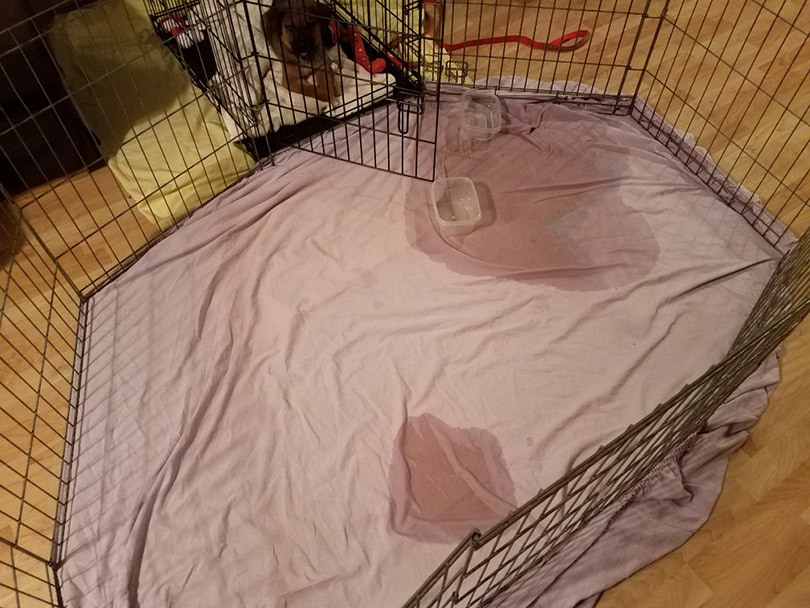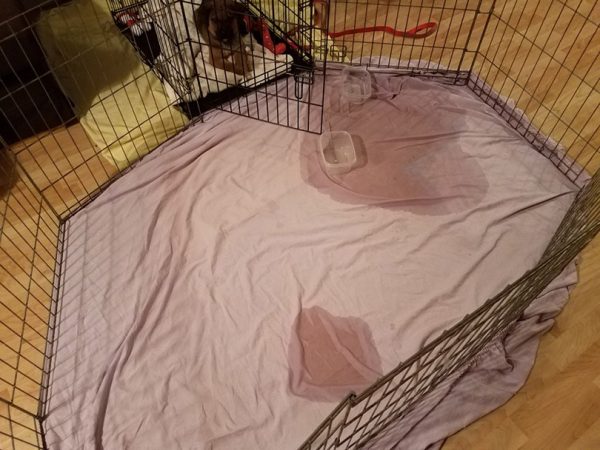Click to Skip Ahead
It is not uncommon for your dog to have a crate accident from time to time. For one reason or another, a puddle and a shamefaced pooch are bound to meet you at the door at some point. Thankfully, it’s nothing a few paper towels can’t handle. Your fur baby is also likely mortified and fearful of being cast out of your good graces.
While an occasional puddle is okay, a consistent mess is not. Unfortunately, it often points to a larger problem.
The quicker you address the issue and correct it, the happier both of you will be. First, though, is figuring out the why? Once you have won that half of the battle, you can plan to correct the problem.
To lend a helping hand, we shared some of the most common issues and solutions below.
First, Ask Yourself Some Questions
Yes, life would be easier if we could simply have a conversation with our pets. Instead, you must use your sleuth skills to gather info on what is going on.
There can be several reasons why your pup is peeing in their crate. It could be due to illness, advancing age, separation anxiety, crate size, etc.
- Is it a new issue?
- Is it happening consistently?
- What is your dog’s age?
- Does your pup have any other symptoms or new behaviors?
- Are there changes to their urine?
- Have you changed their routine?
- How often do you take your dog out?
- Are they anxious?
- Is their crate the right size?
Having the answers to these questions will help you figure out what the cause is so you can try to set it right.
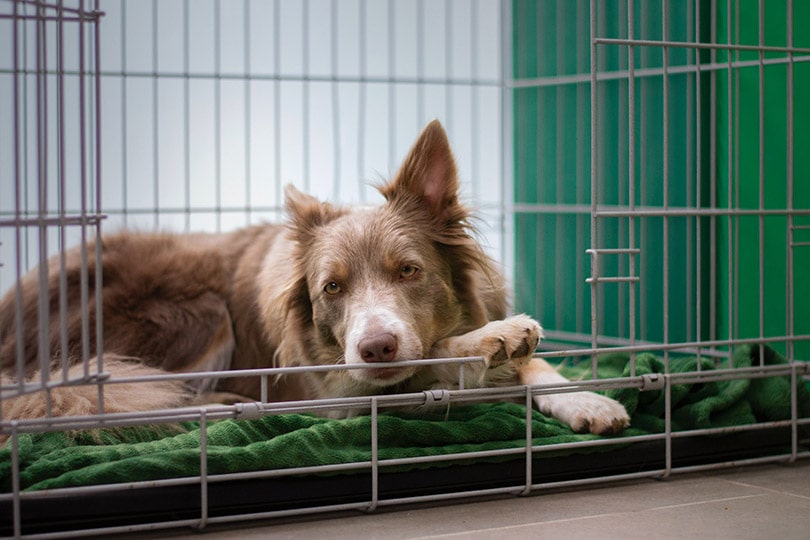

The 6 Reasons Your Dog May Be Peeing in Their Crate
Even if you have an idea of why your dog is having accidents, the solution might not be as easy to find. The first step, however, is understanding the problem. Only then can you find the right solution.
1. Senior Dogs
New and worsening accidents in senior dogs are often related to health issues. When your fur baby reaches their golden years, it’s possible incontinence is the culprit. This is a common malady in aging pets as their bladder muscles weaken.
The only way to be sure this is what your canine is dealing with, is to speak with your veterinarian. They may need to perform diagnostics like bloodwork and a urinalysis, to determine the source of the issue. Treatment will be based on what they find.
Besides medication, increasing potty breaks for your senior pal can help. You may want to consider puppy pads, too. Older dogs that are well-trained won’t be happy about accidents in their crate any more than you. Given the option, they are much more likely to use a pad instead of going in their bed.
Be sure to utilize positive reinforcement. As the saying goes, “you can’t teach an old dog new tricks.” It goes against the grain for a well-trained dog to pee inside unless it’s an emergency.
Make sure you give them plenty of praise and a treat, so they become comfortable with their new routine.

2. Canine Illness and Injuries
It’s important to note that accidents are more likely to happen with puppies and senior dogs. If your normally healthy dog has started going in their crate out of the blue, it’s likely caused by an injury or illness.
A urinary tract infection (UTI) is a common ailment that causes accidents. If left untreated, it can cause serious health issues. Symptoms of UTIs can also mask symptoms of more serious conditions. If you suspect that your dog has a UTI, have him evaluated by your veterinarian.
Spinal cord injuries are injuries that can potentially cause accidents in the house. There are, of course, many other health problems that can cause a loose bladder. To get to the bottom of it, however, the best course of action is to speak with your vet.
If your furball is dealing with an illness or injury, you need to seek help from a professional. That being said, there are a few things you can do to prepare for your vet appointment and speed up the diagnosis process.
- Has their appetite changed?
- Energy levels decreased?
- Do they show signs of pain?
- Have there been changes to their diet?
- Changes in medication?
Although it may be distasteful, you should also examine your fur baby’s pee. As icky as it may be, looking for tell-tale signs of distress are important details your vet needs.
- Dark urine
- Traces of blood
- Strong or strange odors
- Whether they are going when outside
- Change in amount/ average amount is also helpful
These are questions your vet will pose to you, so knowing the answers going into the visit can save you time, and a lot of discomfort for your pup.
3. New Routines
Dogs rely on their routine to balance their life and mark time. They become so used to their schedule, small changes can throw them off causing them to have accidents.
Even small, insignificant changes can rock your pooch’s world. These changes can include:
- Changes to the potty schedule
- Work schedule changes
- Someone permanently left or entered the home
- Significant noise changes
Understandably, changes are likely to happen in life, so the routine is bound to get interrupted. If you have had a recent disruption, it could be the cause of the crate issues.
There are a few ways you can make a new routine easier for your furry friend. Above all, however, easing your pup into a new routine requires patience and time. It is essentially like potty training all over again. It will take repetition for them to become accustomed to the changes.
Keep in mind that changes scare and confuse many dogs. Their previous routine was their way of making you happy, and that is now gone. To make the transition easier, start by spending extra quality time with your pup.
Use positive reinforcement to cheer them on when they do a good job and try to provide extra potty breaks. Most importantly, be sure to stick to the new routine as closely as possible.
- Tip: There will be times when you must change your dog’s routine for a short time due to vacation, illness, job change, etc. If this is the case, keep your expectations realistic. Accidents are likely to happen, but punishing your pet is not the answer. Instead, give extra praise and treats when the kennel is clean, and as always, increase potty breaks.
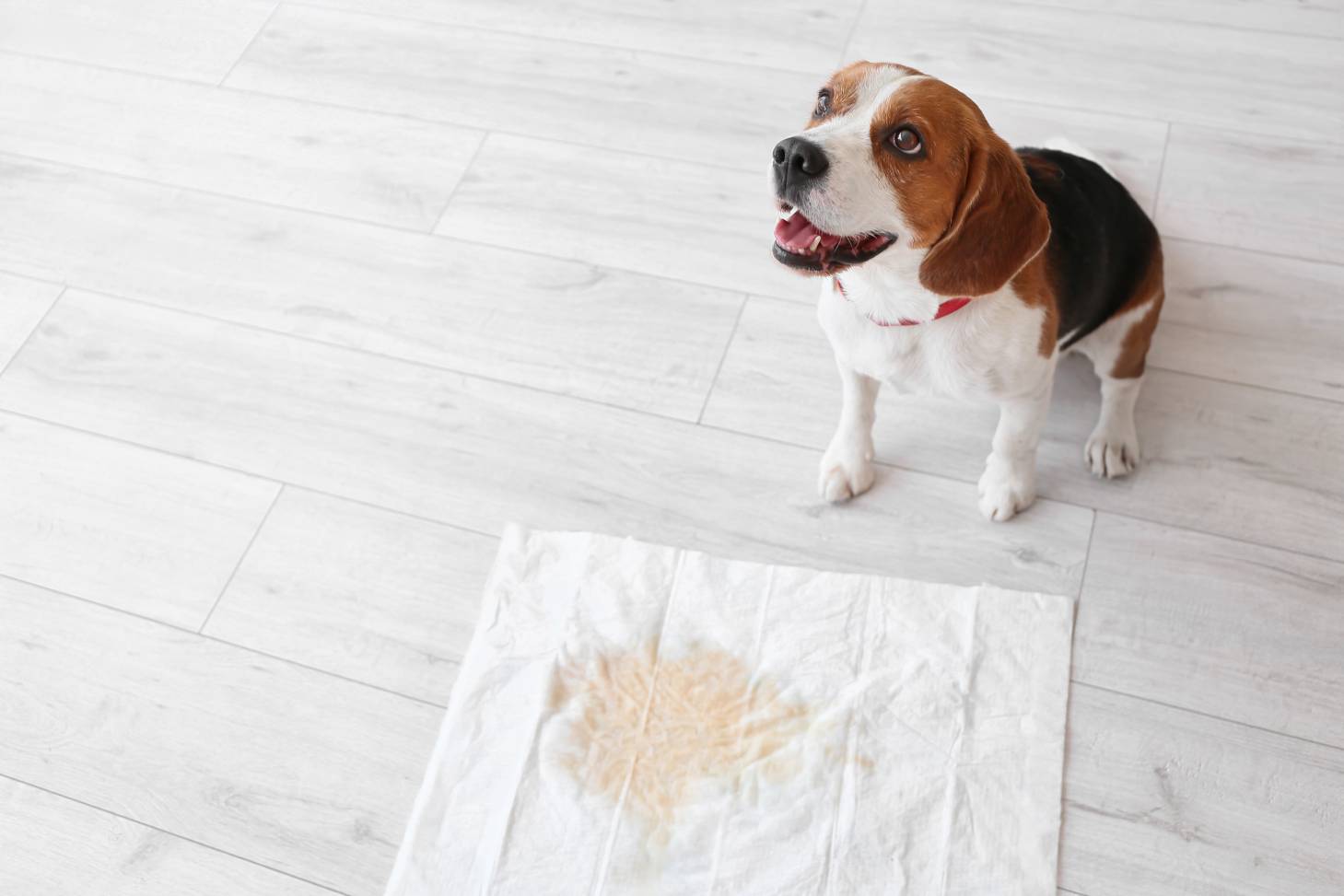
4. Potty Breaks
Sometimes, the simplest answer is right in front of you. That is why it’s important to look at your potty schedule. Increasing the number of times you bring your pup out may very well do the trick.
Figuring out the right number of potty breaks and the length of time between them is a common problem for new pet parents. This is true whether you have a puppy, or you’ve adopted a grown fur baby from a shelter.
The main problem here (unless potty training a puppy) is bladder control. Every dog is different, so there is no hard and fast rule for how long they can hold it. The only exception is with puppies.
Patience and time are going to be key here, along with positive reinforcement. It may take some trial and error, as well. One thing you can try is to start increasing potty breaks by an hour. For example, bring your pet outside every four hours instead of five.
If you have to leave for long periods, see if a family member or neighbor can let your dog out. Additionally, try to take them out at key moments like first thing in the morning, right before bed, after meals, and nap time.
5. Crate Size
Surprising to many pet owners, crates that are too big can be the cause of accidents. Dogs don’t like to go where they sleep. If there is too much space inside their kennel, though, it allows them to divide up the space.
They will devote one corner for using the bathroom while keeping their bedding and lounging space clean. You have a few options to correct this, however.
The first option you have is to reduce the size of the crate. Your dog should be able to fully stretch out, stand up, and turn around in their space. Any bedding should cover the entire expanse of the floor.
Using a smaller crate can often cure your pet’s bathroom renovation ideas.
If you prefer to give your pet a bigger space to hang out, you can also use a divider to section off the crate. Leave bedding on one side and puppy pads on the opposite. This way, the pee won’t get all over everything as they will be going in one designated spot. This is a practical idea if your pup spends long work hours in a crate.
Another option is to remove the bedding altogether. In some cases, dogs use their bedding to cover their accident. Taking it out temporarily can help with this.
Please be aware, you want to watch your dog carefully to ensure this is the overhanging problem before going this route.
If they’re having trouble holding their bladder, have an illness, or have anxiety, removing the bedding is not recommended.
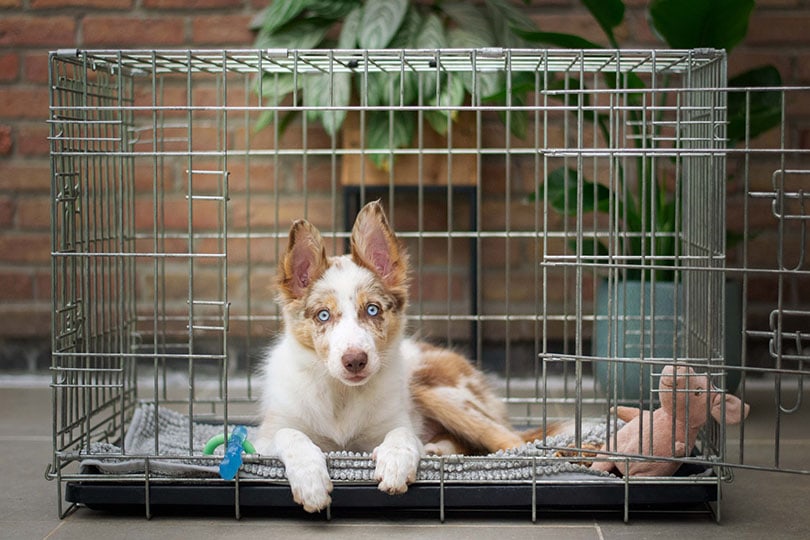
6. Separation Anxiety
Separation anxiety is a behavioral condition that affects many dogs. While some pups only whine, others can bark without stopping and even destroy things. Other symptoms can be seen as well.
The most common causes for anxiety are:
- Changes in routine
- Loss of a family member
- Change of location (moving)
- Addition of a family member (including a new pet)
Once again, curbing this issue and regaining a pee-free crate time for your dog is going to take a lot of time and patience.
Your first course of action is to ensure your pal is getting plenty of exercise and attention when you are home. If possible, your pup should be ready to nap come crate time. You also want to find ways to make their alone time (and your subsequent departure) connected with something positive.
One of the most common ways of doing this is by handing out treats before you leave and as soon as you get home, if they were good. You can also give them a good belly scratch before crate time. Any way you can add positive reinforcement to their routine will help.
Providing them with as much comfort as possible is equally important. Many pet parents find leaving an old shirt inside the kennel with their scent on it is helpful. If your dog is notorious for eating things they aren’t supposed to, this is not the best idea. Make sure they have their favorite toys, comfortable bedding, and even a few treats, as well.
Beyond that, leaving the TV or the radio on to give the illusion someone is home, is also known to work. Thanks to advances in technology, you can even have a treat-dispensing pet camera in your home. This allows you to interact with your pooch while you are away.
Lastly, you want to divert your dog’s attention away from your absence as much as possible. Leaving chew toys or Kongs that you can hide treats in will often keep them occupied. Whatever will hold their attention will lessen the amount of fear they feel when you leave.
- Tip: Our natural inclination is to say goodbye to our pets before leaving. Try to avoid this if your dog suffers from anxiety. Instead, get them used to being in the crate with the door closed while you are in the room. From there, start leaving the room without saying bye. Stay in another room for a while before venturing back (this is where a TV left on in another room comes in handy). Eventually, your fur baby will get used to being in the crate without you there.
Unfortunately, some cases of separation anxiety will require the help of a specialist or your vet. If nothing seems to work, they may be able to help through professional behavioral training and medication.

Summary
No one wants to come home to a pee puddle in your dog’s crate. But when this happens, take a step back and look at the big picture. Where might the problem be coming from? If you suspect this is due to a medical condition, seek veterinary attention. But in all cases, patience and praise are key.
Featured Image by: stockphotofan1, Shutterstock

